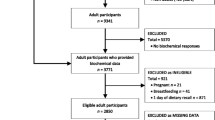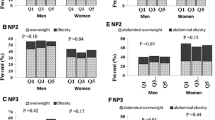Abstract
Purpose
To evaluate how long-term dietary intake of long-chain n-3 polyunsaturated fatty acids (LCn-3 PUFAs), estimated by repeated food frequency questionnaires (FFQs) over 15 years, is correlated with LCn-3 PUFAs in adipose tissue (AT).
Methods
Subcutaneous adipose tissue was obtained in 2003–2004 (AT-03) from 239 randomly selected women, aged 55–75 years, after completion of a 96-item FFQ (FFQ-03). All participants had previously returned an identical FFQ in 1997 (FFQ-97) and a 67-item version in 1987–1990 (FFQ-87). Pearson product-moment correlations were used to evaluate associations between intake of total and individual LCn-3 PUFAs as estimated by the three FFQ assessments and AT-03 content (% of total fatty acids).
Results
FFQ-estimated mean relative intake of LCn-3 PUFAs (% of total fat intake) increased between all three assessments (FFQ-87, 0.55 ± 0.34; FFQ-97, 0.74 ± 0.64; FFQ-03, 0.88 ± 0.56). Validity, in terms of Pearson correlations between FFQ-03 estimates and AT-03 content, was 0.41 (95 % CI 0.30–0.51) for total LCn-3 PUFA and ranged from 0.29 to 0.48 for individual fatty acids; lower correlation was observed among participants with higher percentage body fat. With regard to long-term intake estimates, past dietary intake was also correlated with AT-03 content, with correlation coefficients in the range of 0.21–0.33 and 0.21–0.34 for FFQ-97 and FFQ-87, respectively. The correlations were improved by using average estimates from two or more FFQ assessments. Exclusion of fish oil supplement users (14 %) did not alter the correlations.
Conclusion
These data indicate reasonable validity of FFQ-based estimates of long-term (up to 15 years) LCn-3 PUFA intake, justifying their use in studies of diet-disease associations.
Similar content being viewed by others
References
Mozaffarian D, Wu JH (2011) Omega-3 fatty acids and cardiovascular disease: effects on risk factors, molecular pathways, and clinical events. J Am Coll Cardiol 58:2047–2067
Whelton SP, He J, Whelton PK, Muntner P (2004) Meta-analysis of observational studies on fish intake and coronary heart disease. Am J Cardiol 93:1119–1123
He K, Song Y, Daviglus ML, Liu K, Van Horn L, Dyer AR, Goldbourt U, Greenland P (2004) Fish consumption and incidence of stroke: a meta-analysis of cohort studies. Stroke 35:1538–1542
Arab L, Akbar J (2002) Biomarkers and the measurement of fatty acids. Public Health Nutr 5:865–871
Beynen AC, Hermus RJ, Hautvast JG (1980) A mathematical relationship between the fatty acid composition of the diet and that of the adipose tissue in man. Am J Clin Nutr 33:81–85
Burdge G (2004) Alpha-linolenic acid metabolism in men and women: nutritional and biological implications. Curr Opin Clin Nutr Metab Care 7:137–144
Bergström L, Kylberg E, Hagman U, Erikson H, Bruce A (1991) The food composition database KOST: the National Administration’s information system for nutritive values of food. Vår Föda 43:439–447
Beynen AC, Katan MB (1985) Rapid sampling and long-term storage of subcutaneous adipose-tissue biopsies for determination of fatty acid composition. Am J Clin Nutr 42:317–322
The Swedish Board of Agriculture Statistics Database. http://statistik.sjv.se/Database/Jordbruksverket/databasetree.asp. Accessed Mar 2013
Becker W (1994) Befolkningens kostvanor och näringsintag i Sverige 1989. Metod-och resultatanalys (Dietary habits and nutrient intake in Sweden 1989. The first national food consumption survey). The Swedish National Food Agency, Uppsala
Becker W, Pearson M (2002) Riksmaten 1997–98. Befolkningens kostvanor och näringsintag. Metod-och resultatanalys (Dietary habits and nutrient intake 1997–98. The second national food consumption survey). The Swedish National Food Agency, Uppsala
Amcoff E, Edberg A, Barbieri HE, Lindroos A, Nälsén C, Pearson M, Lemming EW (2012) Riksmaten–vuxna 2010–11. Livsmedels-och näringsintag bland vuxna i Sverige (Dietary habits and nutrient intake in Sweden 2010-11. The third national food consumption survey). The Swedish National Food Agency, Uppsala
Wolk A, Ljung H, Vessby B, Hunter D, Willett WC (1998) Effect of additional questions about fat on the validity of fat estimates from a food frequency questionnaire. Study Group of MRS SWEA. Eur J Clin Nutr 52:186–192
London SJ, Sacks FM, Caesar J, Stampfer MJ, Siguel E, Willett WC (1991) Fatty acid composition of subcutaneous adipose tissue and diet in postmenopausal US women. Am J Clin Nutr 54:340–345
Hunter DJ, Rimm EB, Sacks FM, Stampfer MJ, Colditz GA, Litin LB, Willett WC (1992) Comparison of measures of fatty acid intake by subcutaneous fat aspirate, food frequency questionnaire, and diet records in a free-living population of US men. Am J Epidemiol 135:418–427
Tjonneland A, Overvad K, Thorling E, Ewertz M (1993) Adipose tissue fatty acids as biomarkers of dietary exposure in Danish men and women. Am J Clin Nutr 57:629–633
Godley PA, Campbell MK, Miller C, Gallagher P, Martinson FE, Mohler JL, Sandler RS (1996) Correlation between biomarkers of omega-3 fatty acid consumption and questionnaire data in African American and Caucasian United States males with and without prostatic carcinoma. Cancer Epidemiol Biomarkers Prev 5:115–119
Andersen LF, Solvoll K, Johansson LR, Salminen I, Aro A, Drevon CA (1999) Evaluation of a food frequency questionnaire with weighed records, fatty acids, and alpha-tocopherol in adipose tissue and serum. Am J Epidemiol 150:75–87
Baylin A, Kim MK, Donovan-Palmer A, Siles X, Dougherty L, Tocco P, Campos H (2005) Fasting whole blood as a biomarker of essential fatty acid intake in epidemiologic studies: comparison with adipose tissue and plasma. Am J Epidemiol 162:373–381
Baylin A, Kabagambe EK, Siles X, Campos H (2002) Adipose tissue biomarkers of fatty acid intake. Am J Clin Nutr 76:750–757
Holmes MD, Powell IJ, Campos H, Stampfer MJ, Giovannucci EL, Willett WC (2007) Validation of a food frequency questionnaire measurement of selected nutrients using biological markers in African-American men. Eur J Clin Nutr 61:1328–1336
Ascherio A, Rimm EB, Stampfer MJ, Giovannucci EL, Willett WC (1995) Dietary intake of marine n-3 fatty acids, fish intake, and the risk of coronary disease among men. N Engl J Med 332:977–982
Lopes C, Aro A, Azevedo A, Ramos E, Barros H (2007) Intake and adipose tissue composition of fatty acids and risk of myocardial infarction in a male Portuguese community sample. J Am Diet Assoc 107:276–286
Willett WC (1998) Nutritional epidemiology, 2nd edn. Oxford University Press, New York
Marckmann P, Lassen A, Haraldsdottir J, Sandstrom B (1995) Biomarkers of habitual fish intake in adipose tissue. Am J Clin Nutr 62:956–959
Popp-Snijders C, Blonk MC (1995) Omega-3 fatty acids in adipose tissue of obese patients with non-insulin-dependent diabetes mellitus reflect long-term dietary intake of eicosapentaenoic and docosahexaenoic acid. Am J Clin Nutr 61:360–365
Calder PC, Yaqoob P (2009) Understanding omega-3 polyunsaturated fatty acids. Postgrad Med 121:148–157
Overby NC, Serra-Majem L, Andersen LF (2009) Dietary assessment methods on n-3 fatty acid intake: a systematic review. Br J Nutr 102(Suppl 1):S56–S63
Heitmann BL, Lissner L (1995) Dietary underreporting by obese individuals–is it specific or non-specific? BMJ 311:986–989
Acknowledgments
This research was funded by the Swedish Research Council for Environment, Agricultural Sciences and Spatial Planning (FORMAS). The authors thank Siv Tengblad for analyzing the adipose tissue samples.
Conflict of interest
The authors declare that they have no conflict of interest.
Author information
Authors and Affiliations
Corresponding author
Rights and permissions
About this article
Cite this article
Wallin, A., Di Giuseppe, D., Burgaz, A. et al. Validity of food frequency questionnaire-based estimates of long-term long-chain n-3 polyunsaturated fatty acid intake. Eur J Nutr 53, 549–555 (2014). https://doi.org/10.1007/s00394-013-0563-1
Received:
Accepted:
Published:
Issue Date:
DOI: https://doi.org/10.1007/s00394-013-0563-1




